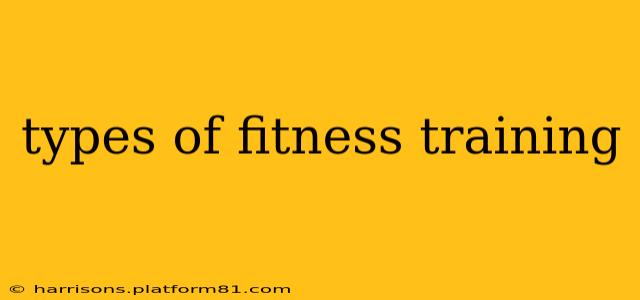Choosing the right type of fitness training can be overwhelming with so many options available. This comprehensive guide explores various fitness training types, highlighting their benefits and helping you determine which best suits your goals and preferences. Understanding the nuances of each method will empower you to create a well-rounded and effective fitness plan.
What are the Different Types of Fitness Training?
Fitness training encompasses a broad spectrum of activities designed to improve physical fitness. These can be broadly categorized, but many types blend elements from several categories. Let's explore some of the most popular:
1. Cardiovascular Training (Cardio)
Cardiovascular training, also known as cardio, is any activity that raises your heart rate and breathing for a sustained period. It's crucial for improving cardiovascular health, burning calories, and boosting endurance.
- Examples: Running, swimming, cycling, dancing, brisk walking, elliptical training.
- Benefits: Improved heart health, weight management, increased stamina, stress reduction.
2. Strength Training
Strength training, also called resistance training, involves using resistance to build muscle mass and increase strength. This can be achieved through weightlifting, bodyweight exercises, or resistance bands.
- Examples: Weightlifting, bodyweight exercises (push-ups, squats, lunges), resistance band exercises.
- Benefits: Increased muscle mass, improved bone density, enhanced metabolism, increased strength and power.
3. Flexibility Training
Flexibility training focuses on improving the range of motion in your joints. This is crucial for preventing injuries, improving posture, and enhancing athletic performance.
- Examples: Yoga, Pilates, stretching (static, dynamic), foam rolling.
- Benefits: Increased flexibility and range of motion, improved posture, injury prevention, reduced muscle soreness.
4. High-Intensity Interval Training (HIIT)
HIIT involves short bursts of intense exercise followed by brief recovery periods. This training method is highly effective for improving cardiovascular fitness and burning calories in a short amount of time.
- Examples: Burpees, sprint intervals, kettlebell swings, jump squats.
- Benefits: Improved cardiovascular fitness, increased calorie burn, efficient use of time.
5. Circuit Training
Circuit training involves performing a series of exercises one after another with minimal rest in between. This is a great way to improve both cardiovascular fitness and strength.
- Examples: Combining various strength training exercises (squats, push-ups, rows) with cardio exercises (jumping jacks, burpees) in a circuit.
- Benefits: Improved cardiovascular fitness, increased strength and muscle endurance, efficient use of time.
6. Functional Fitness Training
Functional fitness focuses on exercises that mimic real-life movements. This type of training improves overall fitness and enhances your ability to perform daily tasks with ease.
- Examples: Squats, lunges, deadlifts, planks, carrying heavy objects.
- Benefits: Improved daily movement capabilities, increased strength and balance, reduced risk of injury.
What are the Benefits of Different Types of Fitness Training?
The benefits of each type of fitness training are numerous and interconnected. A well-rounded fitness program will incorporate various methods to maximize overall health and well-being. The benefits often overlap, but each type has specific advantages:
- Improved Cardiovascular Health: Cardio, HIIT, and Circuit Training are particularly effective in strengthening the heart and lungs.
- Increased Muscle Mass and Strength: Strength Training and Functional Fitness are crucial for building muscle and improving strength.
- Enhanced Flexibility and Mobility: Flexibility Training improves range of motion and prevents injuries.
- Weight Management: Cardio, HIIT, and Strength Training all contribute to weight management by burning calories and boosting metabolism.
- Improved Mental Well-being: Regular exercise of any type can reduce stress, improve mood, and boost overall mental health.
What Type of Fitness Training is Best for Me?
The best type of fitness training for you depends on your individual goals, preferences, and fitness level. Consider your objectives—are you aiming to lose weight, build muscle, improve cardiovascular health, or increase flexibility? Your current fitness level and any physical limitations should also inform your choice. Consulting with a certified personal trainer can provide personalized guidance. Don't be afraid to experiment with different types of training to find what you enjoy and what works best for you. A balanced approach incorporating elements of several types is often the most effective and sustainable path to long-term fitness success.
